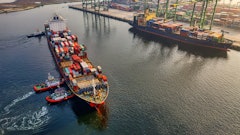
Recent developments in U.S. port operations highlight the strong connection between labor dynamics and technological innovation. Last fall, 45,000 dockworkers threatened a strike driven by stalled contract talks and automation concerns. Pre-strike contingency plans, informed by past disruptions like the pandemic, helped both sides reach a tentative agreement by early January.
The port strike ended with a six-year agreement between the International Longshoremen’s Association (ILA) and the United States Maritime Alliance (USMX), successfully prevented potential disruptions in food logistics and shifted attention to the evolving role of automation at ports.
Let’s explore how these developments are reshaping food supply chains, influencing the broader logistics landscape, and determining the competitive position of U.S. ports in the interconnected global market.
The role of port automation
Considering the variability of automation options and front-end cost can be difficult to project.
But as ports seek to modernize operations, automation is emerging as both an opportunity and a challenge. Advanced technologies, ranging from automated cranes, gates and yard management to predictive maintenance systems, promise enhanced efficiency, improved safety and reduced human error. However, these benefits come with significant investment requirements, extended implementation timelines, and a pressing need for workforce acceptance and retraining.
In the United States, any automation is impactful but there’s a delicate balance between automation advancements and reskilling talent. Tying jobs today and in the future to automation is a win/win. Labor unions and port workers have expressed concerns that rapid technological adoption may jeopardize traditional jobs. Striking a balance between leveraging innovative technologies and safeguarding employment remains a central issue for port authorities. In their agreement, the ILA and USMX recognized the need for compromise, ensuring that automation could be integrated without displacing workers, including commitments to workforce retraining and the creation of roles that complement new technologies.
U.S. ports vs. global port competitiveness
U.S. ports, often limited by restricted operational hours, underinvestment in infrastructure and strict regulatory environments, find themselves at a competitive disadvantage. On the global stage, US ports face stiff competition from counterparts in Asia and Europe that have embraced higher levels of automation.
Additional challenges, such as truck driver shortages and legislative constraints like the Jones Act, which requires that goods transported between U.S. ports must be carried on ships that are built, owned and operated by the United States, further complicate their operational efficiency. The ongoing gap in productivity underscores the necessity for U.S. ports to adopt strategic investments in technology and infrastructure to improve global competitiveness.
Impact on food logistics
To put the monumental import of food through U.S. maritime ports into perspective, just the imports of beer, wine and distilled spirits from the EU alone totaled $4.08 billion in 2024. To cut that channel off would have serious implications to U.S. grocery shelves, foodservice operators and restaurants alike. Other significant food volume coming through U.S. ports annually include:
- Fruits and vegetables: Approximately 20 million metric tons annually, with bananas and avocados being among the top imported fruits.
- Grains and cereals: Roughly 10 million metric tons, with rice and wheat being significant contributors.
- Seafood: Around 5 million metric tons, with shrimp being the most imported seafood item.
- Processed foods: This category can exceed 5 million metric tons, including snacks, sauces and frozen foods.
- Meat and poultry: Approximately 3 million metric tons, with beef and pork being the primary imports.
- Dairy products: About 1 million metric tons, with cheese being the most imported dairy product.
Averting the strike had immediate benefits for food logistics, ensuring that vital supply chains remained intact during a period of potential upheaval. By avoiding prolonged labor disruptions, companies dependent on East and Gulf Coast ports could continue the smooth flow of goods.
This stability is especially critical for industries such as consumer goods and food services, where supply chain disruptions can have widespread economic consequences. When the strike began, there were significant concerns that delays would impact perishable goods like fruits, meats and other food products, exacerbating supply shortages and driving up costs and waste. This incident serves as a catalyst for rethinking supply chain resilience and emphasizes the need for robust risk management and scenario planning to counter future disruptions.
Consumer and retail implications in the food sector
The implications of port operations extend well into the consumer and retail sectors, particularly in the food and quick service restaurant industries. By preventing significant port disruptions, the recent resolution helped ensure that food supply chains remained robust. As the industry increasingly turns to digital tools and AI-powered systems for real-time inventory management and traceability, restaurants are better equipped to handle challenges ranging from supply shortages to regulatory compliance. This integration of technology into supply chain management not only supports operational continuity but also enables companies to meet evolving consumer expectations more effectively.
Additionally, as the uncertainty around tariffs continues, geopolitical volatility on the inbound trade volumes to the United States can impact ports. Automation’s ability to scale up and down to changing trade volumes, to react quickly and avoid clogging the ports can keep getting goods to shelves on time and into customer’s hands. Automation also helps reduce food spoilage and waste and creates an overall reduction in lead times. Effective automation keeps supply lines moving.
However, creating a workforce that supplies the skills automation demands is essential to long-term success. While automation is a part of the next-gen industrial revolution, having a plan to upskill and reskill talent and understanding the unions working to secure jobs will be equally essential to a frictionless logical supply chain.
Looking ahead: balancing innovation and workforce resilience
The resolution of the port strike not only averted immediate disruptions in food logistics but also underscored the need to balance technological innovation with the protection of human capital. As ports increasingly adopt automation to drive operational efficiencies and enhance safety, strategic investments in upskilling and retraining are essential. These efforts will enable dockworkers to transition into roles that support and complement new technologies, preserving job security while boosting productivity.
A collaborative approach among stakeholders – integrating agile supply chain management, targeted infrastructure investments and robust workforce development – is vital for ensuring the long-term viability and global competitiveness of U.S. ports in an increasingly automated and interconnected logistics landscape.
The views reflected in this article are those of the authors and do not necessarily reflect the views of Ernst & Young LLP or other members of the global EY organization.



















